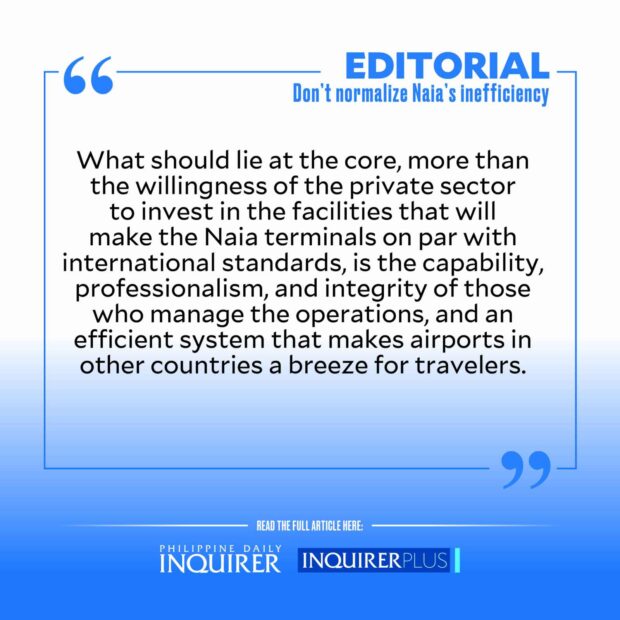
A power disruption has once more hit the Ninoy Aquino International Airport (Naia) — for the third time this year.
That it has happened again hardly surprised anyone given the series of foul-ups at the airports since the year started—that is how low the bar is as far as Naia’s operations are concerned. But it is an inconvenience that should never be normalized, or used as a pretext to justify plans, as some suspect, to privatize the airport’s operations.
That this happened again ahead of another long weekend or holiday — first, it was during the New Year, then Labor Day just over a month ago, and now Independence Day — has raised questions about whether this is deliberate, and unfortunately, at the expense of passengers who wanted to take advantage of the long weekend to travel. In September last year, a blackout also disrupted the operations at Terminal 3, making this the fourth incident — under the Marcos administration — at the terminal that serves both domestic and international flights.
It’s not even a consolation that Friday’s power outage at Terminal 3 lasted only 37 minutes because flight schedules were still affected (“less than 10 flights,” according to an airport official) and passengers were inconvenienced, not to mention the domino effect it caused on the airport’s operations. The half-hour blackout created a build-up at the immigration counters, already notorious for the long queues and has been known to cause passengers to miss their flights even without any power interruption.
The Naia New Year fiasco that paralyzed the country’s entire air navigation system caused the cancellation or delay in hundreds of domestic and international flights leading to losses of over P100 million, with air carriers taking days to fully recover their regular flight schedules. A Senate investigation later found that the malfunction of several pieces of equipment led to a system failure with several lapses on the part of the Civil Aviation Authority of the Philippines (CAAP), particularly its failure to comply with the audit observations of the International Civil Aviation Organization. But besides an apology from CAAP and the Senate’s pronouncements that no one should be above accountability, has there been actual action taken internally by airport authorities or was it merely “performative accountability” all along?
Last month, airport authorities shut down the country’s airspace for two hours to do maintenance work, mainly to replace uninterruptible power supply units at the air traffic management center. Last Friday’s outage was attributed to a lapse during an electrical audit process after a testing cable was left intact causing a shortage and leading to the terminal’s power to trip.
After the New Year shutdown, one would think that the airport operations crew have learned their lessons and become more thorough but apparently not. That it happened again only points to the indifference of airport authorities to the inconvenience that incidents like this can cause passengers and air carriers.“Any disruption in a single process,” said an aviation website, “can trigger a ripple effect which may cause delays in multiple other processes.”
A 12-minute delay, for example, can already cost almost $1,000; an hours-long delay can cripple an industry that is still recovering from the slowdown brought about by the COVID-19 pandemic. For comparison’s sake, a blackout that affected several areas in Malaysia including the Kuala Lumpur International Airport in July last year did not affect flights, and power supply was restored five minutes later — thanks to a reliable power backup as well as efficient operations.
Privatizing Naia is now on the table following the Department of Transportation and the Manila International Airport Authority’s joint proposal for a public-private partnership project. A World Bank blog, “A tale of two airports: Public vs. private,” noted that since the 1950s, there has been a trend to move away from direct government ownership of airports to more involvement from the private sector.
Technicalities of the plan aside, what is important is to improve Naia’s services and end its notorious reputation. The country’s experience with the Cebu and Clark international airports shows that privatizing airport operations can be more efficient. But to view privatization as the ultimate solution to Naia’s woes might be oversimplifying the issue or building too much expectations. What should lie at the core, more than the willingness of the private sector to invest in the facilities that will make the Naia terminals on par with international standards, is the capability, professionalism, and integrity of those who manage the operations, and an efficient system that makes airports in other countries a breeze for travelers.
Power outage is just a symptom of Naia’s many problems; modernization or privatization will be pointless if inefficiency, systemic corruption, and the lack of command responsibility in the country’s main airport prevail. Unless these are addressed, Naia will remain one of the worst airports in the world.